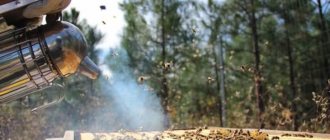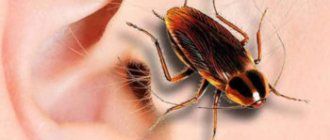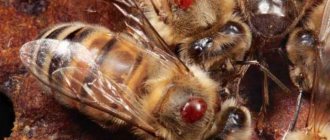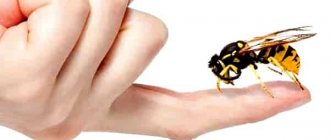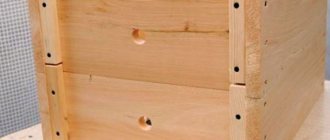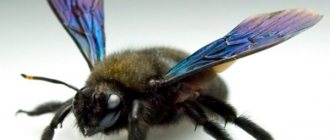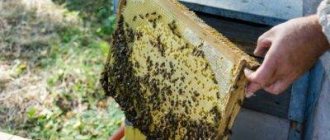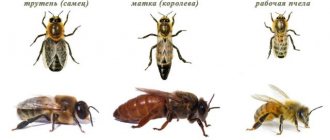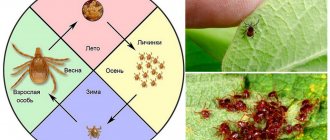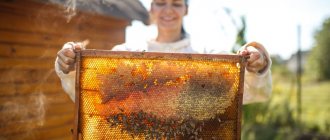Autumn care for bees consists of a rather large list of activities that should complete the period of the main honey collection and prepare the insects for a prosperous, safe winter. Competent beekeepers are sure: the more correctly and well you do your autumn work, the better products you will get next season.
When and in what cases is bee colonies united?
Only a strong and stable colony of insects can survive the winter and live for many years. After the end of the main honey collection, the beekeeper must check the insects and take measures for a successful wintering.
If during the season the bee colony has not managed to increase a sufficient number of individuals, then the method of unification is used to strengthen it. It involves uniting several weak bee colonies into a common one or joining a weak one to a stronger one.
How to unite bees in the fall
The process of uniting bee colonies is simple, and any beekeeper can cope with it. But before moving the swarms into one hive, it is necessary to prepare the insects and create a common smell. Bees recognize a family by its scent and will destroy insects with a different scent from theirs. If you do not take care of creating a common smell in advance, then two bee colonies will destroy each other.
There are several ways to combine flavor:
- Spray each cell of both hives with a weak sugar solution with the addition of aromatic oils of camphor, mint, lemon balm and other plants with a pungent odor.
- Unite two colonies in a common hive, but separate them using a mesh or plywood partition. Then, after some time, the scent of the bees will become uniform, and during the period of scent unification, the insects will not be able to harm each other. Their young brood will share a common scent. Newspaper or sheets of paper can also be used as a partition.
Before combining colonies, the beekeeper must select one queen and place it under a queen cap to prevent it from being damaged. You can leave all the queens in the hive, and then the bees themselves will choose the strongest one and destroy the rest.
Sugar syrup
Uniting bee colonies in the fall through a newspaper
This option involves gradual mixing of the smells of two families. It is smooth and calm for the bees, but more difficult for the beekeeper. It is necessary to constantly monitor the integrity of the partition between them.
A strong swarm is placed in the lower nest with the frames of a multi-body hive, and a newspaper or paper sheet is placed on it. 20 holes are made in the paper using a needle or taps to allow air with insect odors to pass through. The second family is placed in the upper housing.
Uniting bee families before honey harvest
Similarly, bee colonies are united before honey harvest and in the spring. In this case, it is better to combine both methods at once: first spray the honeycombs with a strong-smelling solution, and then transplant them into one hive, separated by a partition. This way you can unite two bee colonies with minimal losses.
Tactics, methods, tips and tricks for merging
Each community in the animal world has its own specific smell, so strangers
will perceive it with aggression, and bees are no exception. Here are some proven ways to unite bee colonies:
- connect a weak community with a stronger one;
- strengthen the middle colony with a queenless group;
- connect a new swarm of bees with an old family;
- to move two disadvantaged communities into one house;
- combine swarms.
Note! Before joining, colonies from different hives are treated with an odorous liquid to disorient the guard insects. Also, before the autumn merging, bees are fed with flavored syrup, so honeycombs with honey from different houses smell the same.
Insects, just like people, must get used to a new team, so September and early October are the best time to unite. In general, there are many ways to combine bees from two hives. The main thing is to do this in good weather, when most of the bees have flown away to get nectar.
Basic Rules
Regardless of the method of combination, these rules are the same for everyone.
- The colony that the beekeeper plans to combine must have no queen. It has either already died, or the beekeeper independently removes it approximately 5-6 hours before the moment of merging (so that the family has time to become orphaned).
- Compatible individuals should smell the same. Like most animals, bees have their own unique smell, with the help of which they recognize each other. In this regard, just before joining, the swarm is sprayed with warm water or syrup with mint drops.
- The procedure should be performed in the late afternoon. At this time, flyers behave more calmly, since at night they are not disturbed by wasps, thieving bees and hornets, and there is no unnecessary noise.
Multihull designs
The process of merging swarms in multi-hull structures is calm and smooth. The beekeeper, on the contrary, must constantly monitor the integrity of the partition between the levels. A strong family is placed in a lower-level nest, with a layer of paper or regular newspaper spread on top. To circulate air with the smell of insects, about 20 holes, or layers, are made in a paper sheet with a needle.
As a rule, 2-3 days are enough for the smells to mix and bee aggression towards new individuals to subside. Instead of paper, you can use plywood or a mesh partition. After the newly formed clan has acquired a uniform smell and the individuals have become accustomed to each other, the partition can be removed.
Note! When a weak and strong bee colony merges, the weak one is moved to the strong one. With identical characteristics, it does not matter on whose territory the connection is made. If both clans are placed in a new hive, this will help to extinguish aggression, and the insects will get used to it faster.
Queenless nests
A colony left without a uterus for some reason needs to be joined to a weaker but healthy colony with a fertile uterus. This is done as follows. In the evening, when the flight stops, the queenless colony is placed next to the colony to which they want to join it. Then the hive with the queen is opened, the side insulation is removed and the board is moved towards the wall of the hive. All the frames of another hive are inserted into the vacated space along with the bees in the same order in which they were in their hive. This should be done quickly in order to disturb the insects less. Then the house with the flyers is closed and left overnight, and the queenless one is removed from the apiary. After some time, the individuals will acquire a common smell and will work together.
Power Leveling
An apiary consisting of equal working communities is a much more efficient farm than one in which the characteristics of bee communities differ from each other. To equalize forces, as a rule, a frame with brood from a powerful community is placed in a weak family. Some time after this procedure, the forces of the two groups are equalized.
Below are three ways to balance the power.
- Transfer of several frames with brood to a weak family.
- Transferring brood frames and bees to a weakened colony.
- Transfer of only bees from a strong colony to a weak one.
Joining the swarm
Swarming is a natural process of multiplying the number of colonies, which beekeepers use to increase their apiary. First of all, a new hive is prepared, into which the swarm is poured and empty frames with dry matter or wax are inserted. The swarm of another community is freed from the queen upon joining with the first. The procedure is carried out in the evening. In the morning, drawn honeycombs will appear on the foundation, and the dryness will be with eggs. Copulation usually takes place without problems, provided that the insects are of the same breed.
Precautionary measures
Beginning beekeepers are wondering: how to unite bees in the fall correctly and without loss? In order for the unification of bee families in the fall to go smoothly, the following conditions must be met:
- Bee families should not be brought together in cold or damp weather;
- To avoid aggression and preserve the gene pool, you need to combine insects of the same breed;
- You will have to constantly monitor the condition of the queen during hatching, because without proper care and feeding she will die.
- You also need to remember about possible enmity within the newly formed family, and monitor the situation daily.
The purpose of uniting families
The union of two different families into one is considered a responsible, important process, which implies the formation of a new healthy family. In this way, you can create a strong, stable, powerful and productive family in the fall.
When a beekeeper wants to combine several bee swarms or families into a single whole, he may have different goals. The most optimal and main task is to create a strong and healthy colony by adding strong bee individuals to the weak ones. However, everything must be done correctly and with extreme caution.
In those families in which there is a queen, you can safely add pre-formed layering. Connecting several families in the fall is a difficult process, since a mutual attack of insects can break out at any moment. Families of such insects are equipped with a special instinct - protective. That is why, in the event of the formation of a foreign and foreign smell, a brutal attack on the “enemies” may begin.
Reasons why a union is performed in an apiary
There are usually several reasons. This is the improvement of weakened groups, the elimination of weak and dysfunctional, unproductive families, the formation of new colonies and the replanting of offspring to weakened families, the creation of strong, viable communities.
Experienced beekeepers know that even with a sufficient amount of food (honey, bee bread), a weakened colony will not be able to survive the winter, since the small number of individuals will not be enough to maintain the required temperature inside the house.
This reason forces the beekeeper to combine several communities into one. He selects two or three small groups of bees to unite them into one strong, viable family.
Proper transplantation of individuals
To prevent swarming and the gathering of families in the fall, and to form a strong and productive hive, you can perform a special unification using transplantation. Proper integration of swarms and families can be accomplished by mixing the honey that was stored in the two hives. Thus, the beekeeper gives the insects an odor foreign to them, which in the future will be perceived as their own. After the transplant, the two families will perceive themselves as one whole. The next stage is the mandatory replacement of the mother with a young, new queen.
It is important! The main rule should be followed when transplanting families. The procedure is performed when both families are weak. This is done for various reasons, but mainly to survive the winter. There is no need to touch numerous, strong families, since their unification will not bring any benefit or effectiveness.
Terms and Conditions
Bees, like people, need to get used to a group, so the end of August-beginning of September and until the beginning of October is considered a good time to unite. This will have a positive effect on the future wintering of the joint family.
The beekeeper must initially examine both colonies and independently decide on combining 2 unrelated offspring. Even with an urgent need to breed a healthy brood and honey cakes, a medical examination must be carried out. Conditions under which a strong family is determined:
- Each brood contains at least 3 individuals;
- 2 future joint houses in one common hive will be healthy;
- Each relative will have food;
- There is a healthy and productive uterus.
This brood is capable of producing strong offspring, can go into a swarm state and survive the winter. In all other cases, when at least one point is violated, it is necessary to unite weak representatives.
Autumn unification
In order for the union of bee families to be successful, the beekeeper must decide on the most optimal time of year. It is important to remember that it is best to transplant families in the summer and spring. If necessary, the procedure can be performed in the autumn so that the family becomes strong and healthy by the time of wintering. There are cases when the uterus dies during honey collection, so they are combined with a special layer of young maternal individuals.
A similar process occurs according to a standard scenario. A newspaper must be distributed between buildings. The queen with brood is placed in the lower housing, and the family without a mother is placed in the upper housing. After a certain period of time, the individuals will gnaw through the paper, resulting in a union. Don't worry about a fight breaking out, because that shouldn't happen. They will have plenty of time to get used to the new scent.
The beekeeper must closely monitor the process, so it is advisable to isolate the queen from the rest. It can be placed in a cage or under a cap. Then it can be released so that the insects can accept it. It is important to feed the insects and also follow a certain principle. This principle states that it is better to preserve a good, fertile uterus than the whole family without it!
Tips and tricks
Practical advice from which more than one generation of beekeepers has learned will help insects survive relocation as painlessly as possible:
- Both houses can be smoked in advance with a smoker to facilitate the transfer;
- A little patience. Insects cannot be rushed, much less moved independently;
- Do not close your eyes. If there is no brood in the house, but you consider the family to be strong, it is better to unite it;
- Monitor the temperature. In October, you need to carefully monitor temperature changes; it is forbidden to combine in sub-zero weather.
The formation of a new “cell” of the bee society requires close attention, so you should not count on the independent formation of a nest of bees. Help the insects, but don't overdo it.
Basic Safety Precautions
Before summing up, it is important to consider all the principles related to the behavior of the beekeeper at the time of such an operation in the apiary:
- The work is carried out in the evening, when almost all insects are sitting in the hives, and their activity is at zero. According to professional beekeepers with many years of experience, such manipulations can begin no earlier than six o’clock in the evening, but no later than eight o’clock.
- Relocation should be carried out in calm, clear weather, so that there are no reasons for aggressive and attacking behavior among insects.
- Do not forget about good, mandatory and nutritious feeding, which is done before or after the procedure.
- Before you begin the manipulation, you need to work with the smoker, namely, blow on the bees. Thus, insects will be able to capture the largest amount of honey products in the proboscis. As a result, they will become calm and peaceful. Consider an equally important factor related to the fact that those individuals who have filled their crop well are perfectly accepted in another hive.
- For successful and fruitful development, it is necessary to transfer weak individuals to stronger ones.
- As for the mother, namely the owner of a particular home, she must first be kept in a cage in order to keep her alive.
- It is desirable that the bees have the same smell, so that the adaptation occurs much more efficiently and successfully. It is important to know that they are able to sense their honeycombs, so with them they will be calmer, more peaceful.
- In beekeeping, it is prohibited to combine infected insects with healthy bees to prevent infection.
If you follow the proposed recommendations and accurate advice, the beekeeper has the opportunity to carry out such work to the highest standard.
Uniting bee colonies in the fall is a familiar and inevitable procedure in every apiary. With any configuration, by the end of summer there will be one or several weak colonies that will not survive the winter. It is recommended to unite bee colonies for better productivity during honey collection.
When beekeepers unite bee colonies
Bee families are united depending on the reason. If the goal is to obtain a family of bees for a good bribe, the union is carried out before the main honey harvest. For a safe winter, beekeepers with experience in beekeeping recommend uniting bee families in September. After analyzing the condition of the colony, the beekeeper determines the feasibility of the event. Promising bee colonies meet the following requirements:
- no signs of infection;
- there is a fertilized queen with good ability to lay eggs;
- the volume of sealed honey is normal;
- the number is sufficient.
If one or more problems are discovered during inspection, bee colonies need correction. Without measures taken, the bee colony will die in cold weather. If she can survive the winter, she will be incapacitated in the spring.
Methods for connecting bee colonies
Each bee colony has a certain smell, which collectors and receivers can easily identify. The introduction of strangers with an unfamiliar smell is perceived with aggression, especially if the bee colony is with its reproductive queen. There are several methods for uniting bee families:
- uniting a weak bee colony with a strong one;
- strengthening an average bee colony with a colony left without a queen;
- creating a honey honey colony based on spring layering;
- connection of a captured swarm and an old family of bees;
- moving two clearly defective nests into a new hive;
- union of swarms.
The treatment disorients the individuals responsible for guarding the hive. Before bee colonies are united in the fall before wintering, the insects are fed the same syrup with the addition of strong-smelling herbs or substances. Capped honey in combs from different hives will have the same smell.
How to unite bees
Insects have a good sense of smell and easily navigate the area. Therefore, they always find the nest unmistakably. To unite two fragile bee colonies, the hives are gradually moved closer to each other. If they plan to move an inferior colony with a strong one, the latter’s house remains in place, and the dwelling intended for release is moved.
Manipulations are carried out in the fall only in good weather, when the working individuals have flown away to collect nectar. The rapprochement takes several days, the timing depends on the distance. On the first day, they are moved 1 m forward or backward, shifted to the sides by 0.5 m. During this time, the pickers will get used to the new location of the home. When the end point is reached, the home of the weak bee colony is removed and the colony is relocated. The collectors will fly to the new hive with a bribe.
If the goal is to unite two weak families of bees, whose nests are located at a great distance from each other, the displacement method is not used. In the evening, each bee colony is fed with syrup, then they are placed in a dark, cool place. During this time, the foragers will forget the location of their former home, then they can be united in a new place for each bee family.
How to unite bee colonies in the fall
In order to unite weak and strong bee colonies in the fall, the frames with brood are first removed from the inferior one. This measure is necessary to control the number of insects in the colony. Bee families with minimal numbers adapt more easily to a new home.
In autumn, the difference between night and day temperatures is quite noticeable. At night, the covers are removed from both hives, and the bee colony gathers in a club to keep warm. In the morning, empty frames are removed, making room for a weak bee colony. The queen is taken from the bee colony intended for relocation.
The frames with the club are placed in a strong nest, fumigated with smoke with the addition of shag or incense. Uniting in the fall does not cause problems; bee families quickly calm down. After a certain time, an inspection is carried out and the vacated frames are removed. Two families of bees winter safely. In the spring, the beekeeper receives a full-fledged colony without signs of aggression between individuals.
How to unite two weak bee colonies into one in the fall
It is necessary to unite bees in the fall from two weak families if there is a threat that neither of them will survive the winter on their own. After the temperature drops, when bee colonies gather in a club, their numbers are clearly visible. Insects located on 4-5 frames will not be able to warm themselves even if there is a sufficient amount of honey.
A bee colony with fewer insects is subject to relocation. Sequencing:
- Remove the covers from the hives and remove the cushions.
- In the evening, empty frames are removed from the nest where the bee colony will move.
- Using a special device, a set of frames with a club is carefully placed next to the stronger bee colony at the outer frame.
- In one room you get 2 clubs with 2 queens and the necessary supply of food.
In the case when it is necessary to unite equally weak families of bees in the fall, it is recommended to use a hive that does not belong to any of them. The transfer principle is the same, both queens are left. In the spring, a strong individual will get rid of a weaker one.
Methods
There are many ways to combine two houses, so each beekeeper selects the conditions for himself. The main thing in autumn is to choose good weather, when the drones have flown away for nectar.
With feeding
There is no need to move the houses, but step-by-step preparation is necessary. On the weakest club you need to put honeycombs with honey, which are 1/3 or half filled. After two weeks, feeding should be repeated to appease and weaken the aggression of insects. Usually they feed 2-3 times, then the insects begin to get used to it, which will affect their productivity.
Now you need to deal with a strong family and check for the presence of a uterus (the examination is carried out in a warm place). After this, the “strong” comb is sent to the fed house. The unification of weak bee colonies on their own is successful if several frames of the strongest of the weak ones are transferred to the weak one. Insects get used to the smell.
Through the partition
The technique will be similar to relocation using newspaper, but it will require the dexterity of a beekeeper. The hive with a weak family is gradually moved closer to the strong one (1-2 meters in 3 days), after which it is placed on the open house of a strong family.
First, a partition made of any wood must be placed between the dwellings. After three days, the insects will get used to the neighbor’s smell, and the partition can be removed. The time for removing the obstacle should be in the evening.
Through the newspaper
The method is widespread in Siberia, where many honey plants bloom early. The method is best used in mid-September:
- One of the hives needs to be moved 1 meter towards the future common house every 2-3 days, turning it 30 degrees;
- Remove the queen a few hours before complete union;
- Both cabins are disinfected to prevent illness;
- Place a regular newspaper on the house of individuals that are considered stronger;
- Place the house of weak offspring on top.
The effectiveness of this method has been noticed more than once, since there is always the strongest of the weak families, which gnaws through the newspaper and takes out the remains from the neighboring hive. Mutual improvement of the new home brings the insects together, so no problems arise.
Through the gangway
In this method, you will need to move both houses towards each other, gradually turning them over. To the house where strong offspring live, you need to place a small sheet of plywood at an angle so that it reaches the last honeycomb. Before relocation, it is important to remove the womb from the weakest, but preserve it.
Now you can begin resettlement. To do this you will need a smoker and a little patience. After the streets become filled with smoke, the hive closes and you need to knock on the walls of the house. After a couple of minutes, the stream of bees, sensing danger, will leave their previous habitat.
During the flight, you need to have time to spray the individuals on the gangplank with a sweet solution of sugar and aromatic herbs so that both houses have the same smell. If there are insects left in the hive, they must be shaken off onto a plywood gangway; they will crawl to their new place of residence. Now you need to wait until each smoked resident has moved along the gangplank to the strongest family, but in no case should you rush them (and do not fumigate them!), as they may leave the apiary.
Spraying
An elementary method that does not require reading thick books on beekeeping. To implement it, it is enough to dissolve sugar in water (1:2) and mix it with a fragrant decoction of honey-bearing herbs. The result should be a sweet and cloying aroma that will help connect the two houses. The main thing you need to remember is the time of its application: the bulk of honey plants should bloom (late August-early September).
Gradually bringing the houses closer by a meter or two over three days helps the bees get used to the landscape. After the hives have converged at one point, you can spray the bees and the hive. This should be the evening when the bees will no longer go to honey collection.
Both families will begin to lick sweet “nectar” from each other and will gradually get used to the common smell.
Uniting bee colonies in August
The autumn union of bee colonies is carried out in order to strengthen the colony for a safe winter. In August, it is necessary to combine insufficiently strong bee colonies with strong ones for better apiary productivity. Weak nests are unprofitable; they will not produce bee products and will not survive the winter. An average colony will produce little honey. Strong colonies of bees will provide for themselves and the beekeeper, and will safely overwinter with a minimum amount of death.
Uniting bee families before honey harvest
For greater productivity of the apiary, before the main honey harvest, beekeeping practices the union of one bee family with another. The spring layering with a young queen, which is sufficiently strong by this time, is taken as a basis. It is enhanced with brood from an old family of bees. It is better to combine nearby vertical hives. Scheme of work:
- From the lower section, all sealed frames with babies are raised to the upper part, and frames with brood from the old queen are added.
- In their place they put sushi or wax.
- Both parts of the housing are insulated from each other with a grid.
- In the old colony, leave 2 frames with brood and substitute dry land.
As a result, it turns out that the lower section with empty honeycombs will be filled with eggs and honey, thus forming another nest. After a certain time, the baby will emerge from the upper tier, freeing the honeycombs for honey. The joint work of layering and young individuals will increase honey productivity. An old swarm can be used to unite bee colonies in the fall or to strengthen a bee colony with an average number of insects.
Common Newbie Questions
The beehive contains a colony and a newly formed branch. Is it worth combining them for honey collection and how to do it correctly?
Bringing the family together during the early days of honey harvesting is sure to increase productivity. The selected queen must be placed in the nucleus, positioning it on the side of the nest. In this case, the hive needs to be expanded by placing a magazine extension on top. If the queen bee is old, she is removed from the developing colony by adding a sealed queen cell to the comb. By the end of summer, the nucleus will get stronger and will be able to spend the winter with the family living next to it.
A three-body hive, divided by solid planks, contains three bee colonies. Should we combine them when the honey harvest begins or continue keeping them on separate floors?
When harvesting honey, one floor will not be enough for the workers. To harvest a decent harvest, you will need frames that occupy three buildings. As soon as the honey plants have bloomed, it is recommended to unite the bees, leaving the strongest of the 3 queens.
Is there a chance that family fights will not start if you move 1-2 frames of bees to another hive?
There will be no battle between families only when moving honeycombs with bees from a queenless layer. When worker bees of equal strength are brought together in one space, battle is inevitable. To strengthen the colony, it is permissible to place sealed brood from another hive, but there should not be worker bees on them.
When is the best time to combine 2 layers from different hives?
The connection of layering is carried out when the first flower nectar appears, and not earlier. Haste will inevitably lead to a fight and death of the “workers”. Weighing the control hive will help determine the exact time. There should be at least 1 kg of honey in it.
Uniting bee colonies is difficult and painstaking work that requires experience and compliance with recommendations. If everything is done correctly, the families will reward the beekeeper with a large bribe and an increase in the number of worker bees.
How to combine two swarms of bees
Bee swarming is a natural process necessary to maintain the population size. Beekeepers use this natural feature of insects to create bee colonies. More often, young individuals with a new queen fly away from the old family. The main thing is not to miss the moment of swarming of insects; the swarm that has flown away never returns to the old nest.
The hive is pre-prepared, the swarm is poured into a new home, and empty frames with wax or drying material are placed. From a swarm of other bees, the queen is removed, and the insects are placed with the first ones. The procedure is carried out in the evening. In the morning there will be drawn honeycombs on the foundation, and the drying ground will contain eggs. The pickers will fly away for a bribe. The union of two or more swarms is always successful. The main condition is that the insects must be of the same breed.
How to combine a bee colony and a captured swarm
Returning a swarm to an old hive is one of the difficult tasks in beekeeping. The swarm flies away with the still unfertilized queen, their task is to form a new nest. He never returns to his old home. Before leaving, the scouts find a place; young individuals do not leave their home without a certain signal. If the swarm has been caught, it will be quite difficult to return it to the former bee colonies; the old queen will not accept them.
For testing, several swarming insects are released through the entrance, and at the same time the nest is smoked. If, despite the smoke, old insects attack swarmers, you should not unite them. This method is rarely used: the young queen is first removed, all the insects are placed in a swarm and treated with a flavoring agent, then poured back into the hive. The method will be effective if the breed has a calm character. With aggressive species, combining a swarm and an old bee colony is undesirable. The caught swarm is placed in the hive, the queen is returned and frames are placed.
Preliminary procedures
Insects can be combined with or without queens. Only the tinder fungus needs to be corrected first. This can be done practically at any time of the season. Of course, you shouldn’t touch insects in winter.
This is interesting The drug Apiton for the treatment of bees
The presence of the uterus in one of the connected nests or in both plays a positive role. To unite families without queens, you need to first calculate what would be better: breed a new queen for her or combine insects with someone else.
It is not recommended to breed queens in the spring, since at this time there are no necessary conditions for obtaining a high-quality individual.
Also, you should not do this in the fall. The mother must emerge from the queen cell no later than September 10, otherwise she will not cope with the difficulties.
In this regard, you should first think carefully about everything and calculate the date of hatching of the queens.
Precautionary measures
To ensure that the union of bees from two or more nests in the fall is successful, the work is carried out taking into account the following recommendations:
- A weak swarm is placed next to a strong one, and not vice versa.
- A sick bee colony, even if it has been treated, cannot be combined with a healthy one; there is a risk of spreading the infection.
- Individuals of different breeds, peaceful and aggressive, should not be placed in the same house.
- The queen is left more reproductive and placed under a hood for several days so that representatives from another bee family get used to it and do not show aggression.
- The work is carried out in the evening after all the insects have returned, then the collectors, tired and inactive, will accept the invasion of strangers more or less calmly.
The colony that is being introduced must be well-fed, with its crops full of nectar. Then the receiving party will not perceive her as a thief.
How to choose a favorable time
Any time of the year is suitable for merging families, but experienced beekeepers advise doing this in the spring, as soon as the hives are moved from wintering to the apiary.
The advantage of spring events is obvious:
- the new family will give more money than the old one;
- bees that survive the winter lose their ability to reproduce and, accordingly, their aggressiveness;
- the family’s own smell is quite weak and protective instincts are not yet developed;
- young bees still do not remember their hive well, so they willingly flock to a new place of residence.
It is especially recommended to carry out the union in the spring for families with dead or weakened queens. In the new team, the worker bees will immediately join the work process and significantly increase the size of the bribe.
Autumn unification is carried out if weakened families are found that are not destined to survive the winter. But for this time of year there is a significant limitation. In the spring, you can unite 2 weak families; in the fall, this is strictly prohibited.
The hive must leave for the winter with a sufficient supply of food, so a weak family is placed with a strong one, subject to several conditions:
- Bees of both families must be absolutely healthy.
- The hive must have a strong, viable queen.
- The bees should have enough food left to last throughout the winter. If there is a deficiency, fertilizing is carried out.
If any of the conditions do not meet the requirements, the colony will not survive the winter cold. But even a surviving swarm will not be able to collect nectar and provide the beekeeper with a sufficient amount of honey.
